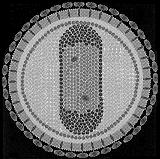Equine infectious anemia
| Equine infectious anemia virus | |
|---|---|
 |
|
| Virus classification | |
| Group: | Group VI (ssRNA-RT) |
| Order: | Unassigned |
| Family: | Retroviridae |
| Subfamily: | Orthoretrovirinae |
| Genus: | Lentivirus |
| Species: | Equine infectious anemia virus |
Equine infectious anemia or equine infectious anaemia (EIA), also known by horsemen as swamp fever, is a horse disease caused by a retrovirus and transmitted by bloodsucking insects. The virus (EIAV) is endemic in the Americas, parts of Europe, the Middle and Far East, Russia, and South Africa. The virus is a lentivirus, like human immunodeficiency virus (HIV). Like HIV, EIA can be transmitted through blood, milk, and body secretions. Transmission is primarily through biting flies, such as the horse-fly and deer-fly. The virus survives up to 4 hours in the vector (epidemiology). Contaminated surgical equipment and recycled needles and syringes, and bits can transmit the disease. Mares can transmit the disease to their foals via the placenta. The risk of transmitting the disease is greatest when an infected horse is ill, as the blood levels of the virus are then highest.
Acute: The acute form is a sudden onset of the disease at full-force. Symptoms include high fever, anemia (due to the breakdown of red blood cells), weakness, swelling of the lower abdomen and legs, weak pulse, and irregular heartbeat. The horse may die suddenly.
Subacute: A slower, less severe progression of the disease. Symptoms include recurrent fever, weight loss, an enlarged spleen (felt during a rectal examination), anemia, and swelling of the lower chest, abdominal wall, penile sheath, scrotum, and legs.
Chronic: Horse tires easily and is unsuitable for work. May have a recurrent fever and anemia, may relapse to the subacute or acute form even several years after the original attack.
...
Wikipedia
